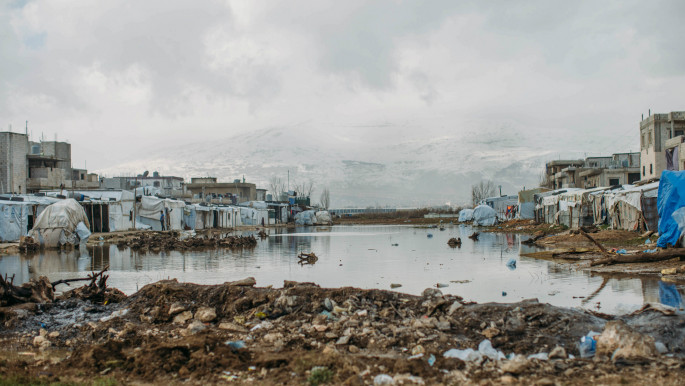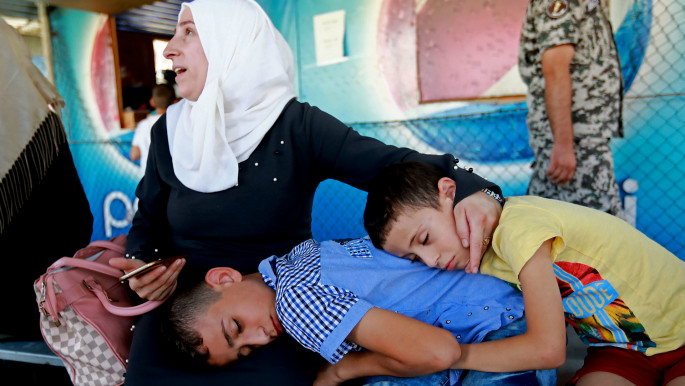In the eye of the storm: Syrian refugee camps in Lebanon destroyed as aid declines
The country's frail infrastructure barely managed to withstand the storm. Rainwater leaked through Beirut's infamous Cola Bridge, while chunks of cement fell off its side. Cars stuck in traffic were submerged in water, including on highways, as Lebanon's Civil Defence volunteers came in dinghies and paddles to help those stuck in the storm.
Lebanon's Internal Security Forces shuffled crowds of people from coastline promenades, where many gathered to observe and take pictures.
At least were 50 have been wounded, and one death has been reported thus far. Fatima, an eight-year-old Syrian girl, went missing, but was later found dead after apparently drowning in a river.
Refugees in the eye of the storm
Several Syrian refugee camps have also been flooded and destroyed. An Arabic social media hashtag campaign that translates to "refugees in the eye of the storm" was commonly used as people posted photos and videos of Syrian refugee tents and settlements affected by the storm.
A widely shared photo of informal refugee settlements in the northeastern border town of Arsal was among those widely shared. Dozens of tests were covered in thick snow, some appearing almost entirely submerged.
In a video of a destroyed encampment in Bar Elias in Lebanon's eastern Bekaa Valley region, stone blocks, plastic water tankers, and wooden pallets float aimlessly as Syrian refugees rush to take as many personal belongings as possible from their tents. Photos of tents and other informal shelters collapsing due to soil erosion were also widespread.
"Around 850 informal settlements, hosting 50,000 refugees, are at risk of flooding," United Nations High Commissioner for Refugees Public Information Officer Lisa Abou Khaled told The New Arab.
The UN agency stated in a document on January 7 that 150 settlements have been damaged thus far, affected some 8,000 refugees. Abou Khaled added that the UNHCR alongside local municipalities and Lebanon's ministry of social affairs have been cooperating in the relief effort.
"Efforts to pump out water accumulating in informal tented settlements in the Bekaa are ongoing," she told The New Arab. "It has proved to be a challenging task as water keeps pouring back due to the fact that some informal settlements are located below the level of the road and continuous rainfall continues to accumulate."
 |
|
| Several Syrian camps in Lebanon have been hit hard by Storm Norma [Getty] |
Lebanese security forces were also active in limited capacities. Lebanese Red Cross Secretary General Georges Kettaneh added that the army was distributing bread to refugees stranded in northern Lebanon. Elsewhere, some police stations were being used as makeshift shelters. Local radio station Voix Du Liban reported that Dahr el-Baidar's police station sheltered 55 Syrians stranded in the snow.
Lebanon's State Ministry for Displaced Affairs urged UN agencies and aid groups to help the refugees and aggregated content on social media, with Minister Mouin Merhebi later meeting with Lebanon Representative for the UNHCR Mireille Girard to implement means of protecting refugees from flooding.
Small local non-government organisations scrambled across the country, trying to contribute to the aid effort as much as they could. Groups like Sawa for Development and Aid called for emergency funds and donations to help their winter efforts for evacuated families. In addition, unaffiliated volunteers and activists organised donation and collection drives through various social media channels.
While The New Arab was unable to reach Sawa, the organisation urged in a public statement for municipalities, churches, and mosques to help with the evacuation process, and to open up schools as temporary shelters.
Other NGOs tried to do what they could. Anas Tello, a volunteer for Women Now For Development told The New Arab that they opened their two offices in the central Bekaa region to temporary house evacuated refugees.
"We opened the centres so people can stay over, and we're trying to cooperate with other organisations. We work in development, education, and [economic] empowerment- not aid," Tello added. "We couldn't do more. It's a disaster."
Tello from Women Now For Development expressed concern that financial support for humanitarian organisations continues to decline.
Donor fatigue and fear of returns
International donations to the UNHCR and other organisations supporting refugees continue to decline. Last year was the worst year yet; the UNHCR was only able to secure 45 percent of its required funds. And because of this, it comes to no surprise that living conditions for refugees have declined too.
The 2018 Vulnerability Assessment of Syrian Refugees in Lebanon revealed that more Syrian refugees have moved from residential housing to non-permanent forms of housing (i.e. tents) or non-residential locations, such as garages or workshops.
As donations decline, refugee returns have increased, administered by Lebanese General Security. In a statement published in November 2018, the security agency reported that 87,670 Syrian refugees returned since July of that same year. While many Lebanese officials, notably Foreign Minister Gebran Bassil, reiterate calls for swift returns, claiming that Syria is now "mostly safe", State Minister for Displaced Affairs Mouin Merhebi earlier said that some refugees that have returned from Lebanon were killed by the Syrian government.
Human Rights Watch Lebanon Research Aya Majzoub told The New Arab that international donor fatigue and the adverse effects it has on the living conditions of Syrian refugees is a major cause for concern.
"Conditions for refugees in Lebanon continue to be bleak," Majzoub said. "Families are being forced to choose between living undignified lives here in Lebanon or risking their safety and lives and returning to Syria."
She added that the international community needs to "step up" its humanitarian aid, and that the conversation is "prematurely" focusing on reconstruction as donations decline.
"Syrian families are [ultimately] paying the price."
Refugees try to take matters into their own hands
With refugees reluctant to return to a Syria without their security guaranteed, and declining conditions in Lebanon, some are trying to take the initiative to solve hardships that they face in their respective communities.
Omama, a Syrian who moved to Lebanon less than four years ago, settled in the eastern Zahle district. She realised that she and many others around her faced significant issues with affordable and reliable transportation.
"They would have to walk at least 20 minutes to get to the public bus," she explained to The New Arab. "To get to main roads [from refugee settlements], they have to walk long distances or try to get a taxi, which is unaffordable." Some tried to use motorcycles, but most would be compounded.
She realised that not far from the town of Saadnayel near Zahle was a much more vulnerable area with a large refugee population called Omrieh. Omama explained that it was once a large plot of land with some homes for a wealthy family but was rented out to Syrians fleeing from the clashes in Homs. Access to hospitals and clinics were even more difficult for those living there.
So, she decided to try and implement a bus route between the two areas to ease access to medical services and for better freedom of movement.
Omama came up with that idea at a pilot programme for Community Moblization in Crisis, by the University of Ottawa in collaboration with the American University of Beirut. There, they supported her and other participants to develop their projects and initiatives, hoping they would come to life.
While the project hasn't come to life yet, she's adamant that it will work out.
"People know what their problems are and know the best course of action to bring about a solution," Diana Richani, Programme Manager at Community Moblization in Crisis told The New Arab, explaining that the project targets both refugee and host communities. Richani adds that the effort is to "break the cycle" of depending on aid and agencies that are "most often bound to donor needs and requirements."
Anticipating donor fatigue to worsen and to reach a stage where support can't be offered anymore, "communities can rise up and practice their agency in matters that affect them first hand."
Kareem Chehayeb is a Lebanese writer and musician based in Beirut.
Follow him on Twitter: @chehayebk






 Follow the Middle East's top stories in English at The New Arab on Google News
Follow the Middle East's top stories in English at The New Arab on Google News


